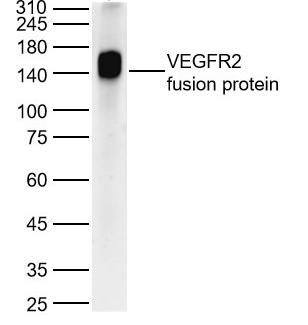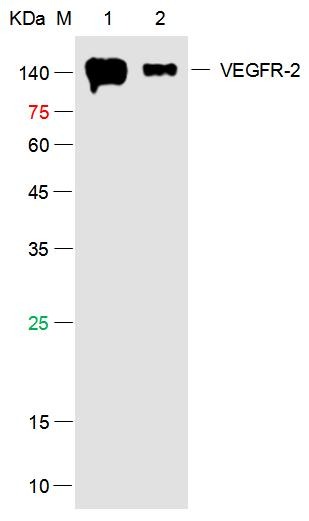Shopping Cart
Remove All Your shopping cart is currently empty
Your shopping cart is currently empty
Anti-VEGFR2/KDR Polyclonal Antibody 2 is a Rabbit antibody targeting VEGFR2/KDR. Anti-VEGFR2/KDR Polyclonal Antibody 2 can be used in WB.
| Pack Size | Price | USA Warehouse | Global Warehouse | Quantity |
|---|---|---|---|---|
| 50 μL | $221 | 7-10 days | 7-10 days | |
| 100 μL | $372 | 7-10 days | 7-10 days | |
| 200 μL | $529 | 7-10 days | 7-10 days |
| Description | Anti-VEGFR2/KDR Polyclonal Antibody 2 is a Rabbit antibody targeting VEGFR2/KDR. Anti-VEGFR2/KDR Polyclonal Antibody 2 can be used in WB. |
| Synonyms | VEGFR2, VEGFR, kinase insert domain receptor, Flk-1, FLK1, CD309 |
| Ig Type | IgG |
| Reactivity | Human |
| Verified Activity | 1. Sample: Lane 1: Recombinant human VEGFR2 protein, His (HEK293) Primary: Anti-VEGFR2 (TMAB-01958) at 1/1000 dilution Secondary: IRDye800CW Goat Anti-Rabbit IgG at 1/20000 dilution Predicted band size: 147 kDa Observed band size: 147 kDa 2. Sample: Lane 1: Recombinant Human VEGFR2 Protein at 500ng Lane 2: Recombinant Human VEGFR2 Protein at 50ng Primary: Rabbit Anti-VEGFR-2 Polyclonal Antibody at 1/1000 dilution (Cat.TMAB-01958) Secondary: IRDye800CW Goat Anti-Rabbit IgG at 1/20000 dilution Predicted band size: 87 kDa Observed band size: 125-155 kD   |
| Application | |
| Recommended Dose | WB: 1:500-2000 |
| Antibody Type | Polyclonal |
| Host Species | Rabbit |
| Subcellular Localization | Isoform 1: Cell membrane; Single-pass type I membrane protein. Cytoplasm. Nucleus. Cytoplasmic vesicle. Early endosome. Note=Detected on caveolae-enriched lipid rafts at the cell surface. Is recycled from the plasma membrane to endosomes and back again. Phosphorylation triggered by VEGFA binding promotes internalization and subsequent degradation. VEGFA binding triggers internalization and translocation to the nucleus. Isoform 2: Secreted (Probable).Isoform 3: Secreted. |
| Tissue Specificity | Detected in cornea (at protein level). Widely expressed. |
| Construction | Polyclonal Antibody |
| Purification | Protein A purified |
| Appearance | Liquid |
| Formulation | 0.01M TBS (pH7.4) with 1% BSA, 0.02% Proclin300 and 50% Glycerol. |
| Concentration | 1 mg/mL |
| Research Background | Vascular endothelial growth factor (VEGF) is a major growth factor for endothelial cells. This gene encodes one of the two receptors of the VEGF. This receptor, known as kinase insert domain receptor, is a type III receptor tyrosine kinase. It functions as the main mediator of VEGF-induced endothelial proliferation, survival, migration, tubular morphogenesis and sprouting. The signalling and trafficking of this receptor are regulated by multiple factors, including Rab GTPase, P2Y purine nucleotide receptor, integrin alphaVbeta3, T-cell protein tyrosine phosphatase, etc.. Mutations of this gene are implicated in infantile capillary hemangiomas. [provided by RefSeq, May 2009]. |
| Immunogen | KLH conjugated synthetic peptide: human VEGFR2 |
| Antigen Species | Human |
| Gene Name | KDR |
| Gene ID | |
| Protein Name | Vascular endothelial growth factor receptor 2 |
| Uniprot ID | |
| Biology Area | Response to hypoxia,VEGF,Angiogenic growth factors,Growth factor receptors,Endothelial Cell Markers,VEGF Receptors,Endothelial Cells,Hypoxia,Host Virus Interaction,VEGF,Receptor Tyrosine Kinases,Endothelial Markers,Surface Molecules |
| Function | Tyrosine-protein kinase that acts as a cell-surface receptor for VEGFA, VEGFC and VEGFD. Plays an essential role in the regulation of angiogenesis, vascular development, vascular permeability, and embryonic hematopoiesis. Promotes proliferation, survival, migration and differentiation of endothelial cells. Promotes reorganization of the actin cytoskeleton. Isoforms lacking a transmembrane domain, such as isoform 2 and isoform 3, may function as decoy receptors for VEGFA, VEGFC and/or VEGFD. Isoform 2 plays an important role as negative regulator of VEGFA-and VEGFC-mediated lymphangiogenesis by limiting the amount of free VEGFA and/or VEGFC and preventing their binding to FLT4. Modulates FLT1 and FLT4 signaling by forming heterodimers. Binding of vascular growth factors to isoform 1 leads to the activation of several signaling cascades. Activation of PLCG1 leads to the production of the cellular signaling molecules diacylglycerol and inositol 1,4,5-trisphosphate and the activation of protein kinase C. Mediates activation of MAPK1/ERK2, MAPK3/ERK1 and the MAP kinase signaling pathway, as well as of the AKT1 signaling pathway. Mediates phosphorylation of PIK3R1, the regulatory subunit of phosphatidylinositol 3-kinase, reorganization of the actin cytoskeleton and activation of PTK2/FAK1. Required for VEGFA-mediated induction of NOS2 and NOS3, leading to the production of the signaling molecule nitric oxide (NO) by endothelial cells. Phosphorylates PLCG1. Promotes phosphorylation of FYN, NCK1, NOS3, PIK3R1, PTK2/FAK1 and SRC. |
| Molecular Weight | Theoretical: 147 kDa. |
| Stability & Storage | Store at -20°C or -80°C for 12 months. Avoid repeated freeze-thaw cycles. |
| Transport | Shipping with blue ice. |
| Size | Quantity | Unit Price | Amount | Operation |
|---|

Copyright © 2015-2025 TargetMol Chemicals Inc. All Rights Reserved.